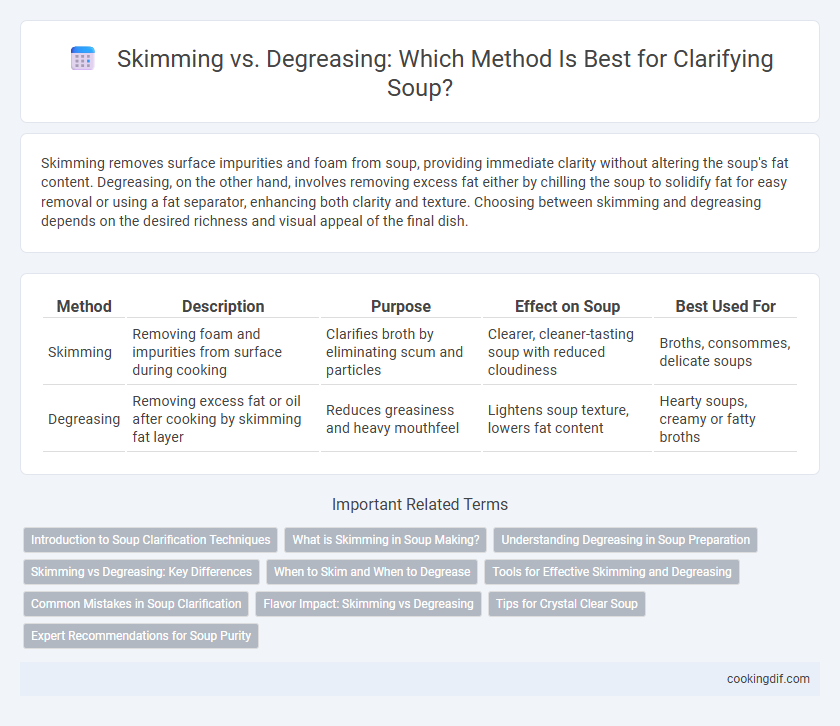Skimming removes surface impurities and foam from soup, providing immediate clarity without altering the soup's fat content. Degreasing, on the other hand, involves removing excess fat either by chilling the soup to solidify fat for easy removal or using a fat separator, enhancing both clarity and texture. Choosing between skimming and degreasing depends on the desired richness and visual appeal of the final dish.
Table of Comparison
| Method | Description | Purpose | Effect on Soup | Best Used For |
|---|---|---|---|---|
| Skimming | Removing foam and impurities from surface during cooking | Clarifies broth by eliminating scum and particles | Clearer, cleaner-tasting soup with reduced cloudiness | Broths, consommes, delicate soups |
| Degreasing | Removing excess fat or oil after cooking by skimming fat layer | Reduces greasiness and heavy mouthfeel | Lightens soup texture, lowers fat content | Hearty soups, creamy or fatty broths |
Introduction to Soup Clarification Techniques
Skimming involves gently removing the foam and impurities that rise to the surface of simmering soup, enhancing clarity and flavor without altering the fat content significantly. Degreasing, on the other hand, specifically targets and removes excess fat by chilling the soup and lifting solidified fat layers, resulting in a cleaner, less oily broth. Both techniques contribute to a clearer, more refined presentation and taste, essential for high-quality consommes and delicate soups.
What is Skimming in Soup Making?
Skimming in soup making involves removing foam, impurities, and fat that rise to the surface during cooking to achieve a clearer and cleaner broth. This process enhances the soup's texture and flavor by preventing cloudiness and bitterness caused by excess proteins and fats. Effective skimming requires a fine mesh skimmer or spoon to gently lift off debris without disturbing the simmering liquid.
Understanding Degreasing in Soup Preparation
Degreasing soup involves removing excess fat that rises to the surface after cooking, improving clarity and reducing greasiness without losing flavor. Unlike skimming, which removes foam and impurities early in the cooking process, degreasing is performed after cooling or chilling the soup to solidify fat for easier removal. Effective degreasing enhances the soup's texture and presentation, making it more appealing and lighter on the palate.
Skimming vs Degreasing: Key Differences
Skimming involves removing impurities or foam from the surface of the soup, ensuring clarity and a cleaner taste, while degreasing targets the removal of excess fat to reduce oiliness and improve texture. Skimming is usually performed during the initial cooking stages to prevent cloudiness, whereas degreasing is often done after cooking when the fat solidifies on top. Both techniques contribute to a clearer, more refined soup but address different elements: skimming focuses on surface scum, degreasing removes fat layers.
When to Skim and When to Degrease
Skimming is essential during the initial stages of cooking soup to remove impurities and foam that rise to the surface, ensuring a clearer broth. Degreasing is best applied after cooking when excess fat solidifies on the surface, allowing for easy removal to prevent greasy texture and improve flavor. Use skimming early for clarity and degreasing later for a clean, rich taste.
Tools for Effective Skimming and Degreasing
Effective skimming relies on fine-mesh ladles or specialized skimmers to swiftly remove impurities and foam from the soup surface. Degreasing benefits from chilled spoons or fat separators designed to solidify and lift excess fat without disturbing the broth's clarity. Utilizing silicone-tipped tongs and angled spoons enhances precision, ensuring a clear, refined consomme.
Common Mistakes in Soup Clarification
Skimming soup often removes only the surface fat, leaving impurities dissolved in the liquid, which results in cloudy broth. Degreasing techniques that rely solely on chilling to solidify fat may overlook proteins and sediments that cause cloudiness. Common mistakes include failing to combine both methods or using improper tools, leading to insufficient clarification and compromised soup flavor and appearance.
Flavor Impact: Skimming vs Degreasing
Skimming removes impurities and foam from the surface of soup, resulting in a cleaner and more refined flavor profile by eliminating bitterness and off-flavors. Degreasing targets excess fat, which can create a greasy mouthfeel and overpower delicate ingredients if left unchecked. Both techniques enhance the overall taste, but skimming primarily improves clarity and purity, while degreasing balances richness and lightness in the final dish.
Tips for Crystal Clear Soup
Skimming involves gently removing foam and impurities from the surface during simmering to achieve a clear broth, while degreasing focuses on removing excess fat after cooking for a cleaner taste and appearance. Use a fine mesh skimmer or spoon to regularly lift off scum in the early stages of cooking and refrigerate the soup briefly to solidify fat for easier removal. Combining these techniques ensures a crystal clear soup with enhanced flavor and an appealing, translucent finish.
Expert Recommendations for Soup Purity
Experts recommend skimming as the primary method for clarifying soup, emphasizing the removal of foam and impurities from the surface during cooking to enhance flavor and appearance. Degreasing is advised for reducing excess fat after cooking, using tools like fat separators or chilling the soup to solidify fat for easy removal, ensuring a cleaner, richer broth. Prioritizing skimming during simmering, followed by degreasing, achieves optimal soup purity praised in culinary best practices.
Skimming vs Degreasing for clarifying Infographic

 cookingdif.com
cookingdif.com